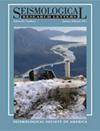Follow the Trace: Becoming a Seismo‐Detective with a Campus‐Based Raspberry Shake Seismometer
IF 3.2
3区 地球科学
Q2 GEOCHEMISTRY & GEOPHYSICS
引用次数: 0
Abstract
Seismic signals, whether caused by earthquakes, other natural phenomena, or artificial noise sources, have specific characteristics in the time and frequency domains that contain crucial information reflecting their source. The analysis of seismic time series is an essential part of every seismology‐oriented study program. Enabling students to work with data collected from their own campus, including signals from both anthropogenic and natural seismic sources, can provide vivid, practical examples to make abstract concepts communicated in classes more concrete and relevant. Data from research‐grade broadband seismometers enable us to record time series of vibrations at a broad range of frequencies; however, these sensors are costly and are often deployed in remote places. Participation in the Raspberry Shake citizen science network enables seismology educators to record seismic signals on our own campuses and use these recordings in our classrooms and for public outreach. Yale University installed a Raspberry Shake three‐component, low‐cost seismometer in the Earth and Planetary Sciences department building in Summer 2022, enabling the detection of local, regional, and teleseismic earthquakes, microseismic noise, and anthropogenic noise sources from building construction, an explosive event in a steam tunnel, and general building use. Here, we discuss and illustrate the use of data from our Raspberry Shake in outreach and education activities at Yale. In particular, we highlight a series of ObsPy‐based exercises that will be used in courses taught in our department, including our upper‐level Introduction to Seismology course and our undergraduate classes on Natural Disasters and Forensic Geoscience.追踪踪迹:利用校园树莓震源地震仪成为地震侦探
无论是由地震、其他自然现象还是人工噪声源引起的地震信号,都具有特定的时域和频域特征,其中包含反映其来源的重要信息。地震时间序列分析是每一个地震学研究项目的重要组成部分。让学生使用从自己校园收集的数据(包括来自人为和自然震源的信号),可以提供生动、实用的例子,使课堂上传达的抽象概念更加具体和贴切。研究级宽带地震仪的数据使我们能够记录各种频率的振动时间序列;但是,这些传感器成本高昂,而且通常部署在偏远地区。参与 Raspberry Shake 公民科学网络使地震学教育工作者能够在我们自己的校园内记录地震信号,并将这些记录用于我们的课堂和公众宣传。耶鲁大学于 2022 年夏季在地球与行星科学系大楼安装了一个树莓震三分量低成本地震仪,从而能够探测本地、区域和远震地震、微震噪声以及来自建筑施工、蒸汽隧道爆炸事件和一般建筑使用的人为噪声源。在此,我们将讨论并说明在耶鲁大学的外联和教育活动中如何使用树莓震颤仪的数据。我们特别强调了一系列基于ObsPy的练习,这些练习将用于我们系的课程中,包括地震学高级入门课程以及自然灾害和法医地球科学本科课程。
本文章由计算机程序翻译,如有差异,请以英文原文为准。
求助全文
约1分钟内获得全文
求助全文
来源期刊

Seismological Research Letters
地学-地球化学与地球物理
CiteScore
6.60
自引率
12.10%
发文量
239
审稿时长
3 months
期刊介绍:
Information not localized
 求助内容:
求助内容: 应助结果提醒方式:
应助结果提醒方式:


